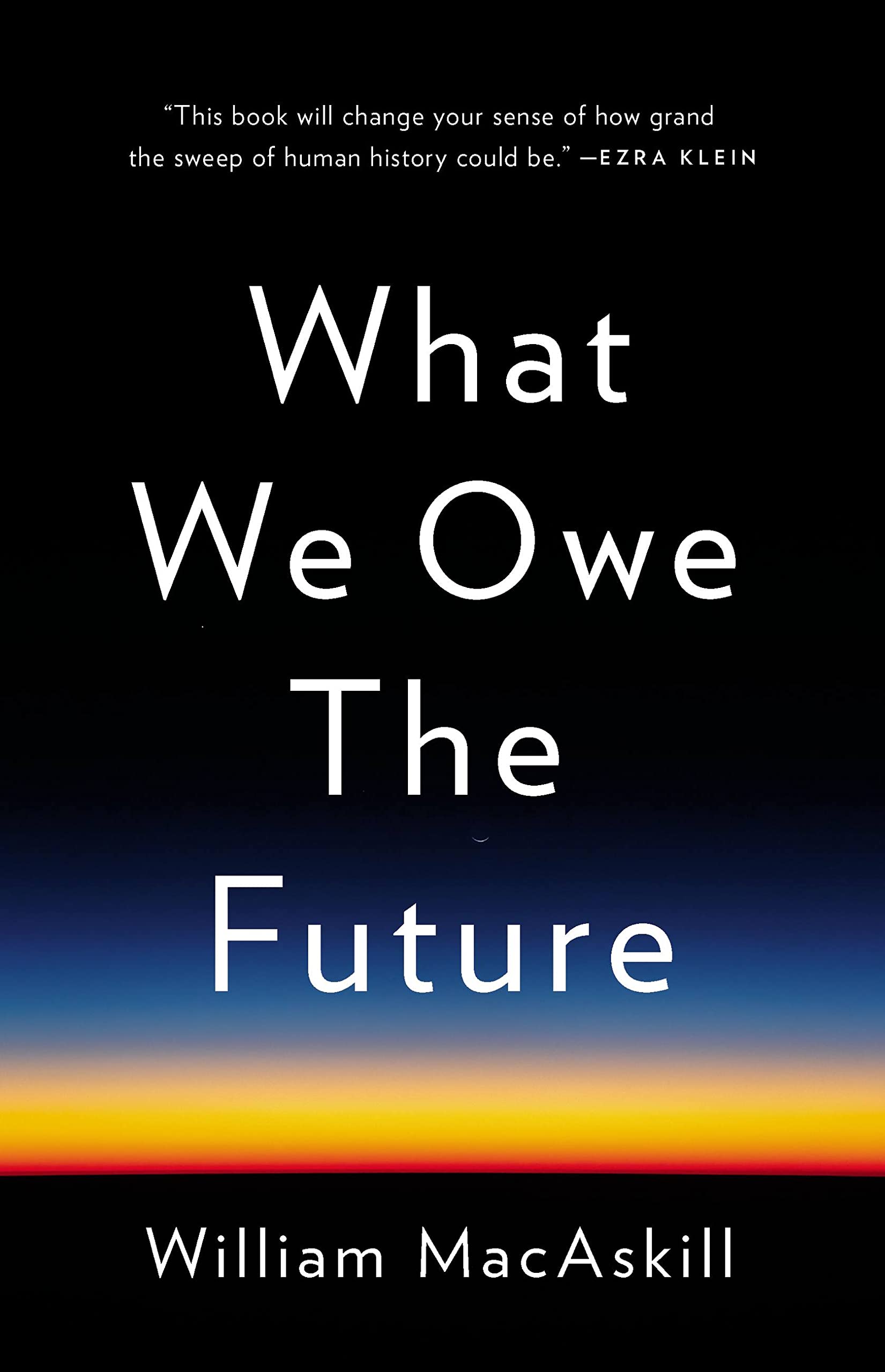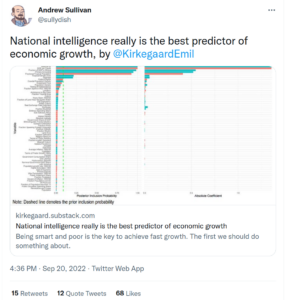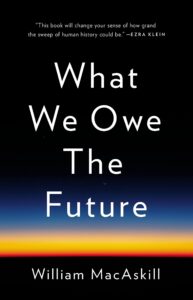
While I am no longer the philosophy blogger I once was, I do occasionally read philosophy that’s got something to do with science. I saw some references to this book from Scott Alexander and others, so I decided to give it a read. I avoided reading book reviews before reading it on my own to force a more original take. You can judge how well I succeeded. The book currently enjoys a 4.11 rating on Goodreads, and 4.20 on Amazon, which is half-decent. But then again, the largely incorrect and dishonest Mismeasure of Man by SJ Gould has an Amazon rating of 4.6, and 4.05 on Goodreads, so maybe we shouldn’t put much faith in such ratings.
So, what is the book about? It’s a mix of utilitarian philosophy of ethics, and practical considerations of what seems important going forward for humanity. The book’s own description:
The fate of the world is in our hands. Humanity’s written history spans only five thousand years. Our yet-unwritten future could last for millions more — or it could end tomorrow. Astonishing numbers of people could lead lives of great happiness or unimaginable suffering, or never live at all, depending on what we choose to do today.
In What We Owe The Future, philosopher William MacAskill argues for longtermism, that idea that positively influencing the distant future is a key moral priority of our time. From this perspective, it’s not enough to reverse climate change or avert the next pandemic. We must ensure that civilization would rebound if it collapsed; counter the end of moral progress; and prepare for a planet where the smartest beings are digital, not human.
If we make wise choices today, our grandchildren’s grandchildren will thrive, knowing we did everything we could to give them a world full of justice, hope and beauty.
Longtermism really is just the opposite of the current ADHD tendency towards immediate gratification, high time preference, etc. Reading the table of contents actually shows what the book is about in a lot nicer way:
- PART I. THE LONG VIEW
- Introduction
- Chapter 1: The Case for Longtermism
- Chapter 2: You Can Shape the Course of History
- PART II. TRAJECTORY CHANGES
- Chapter 3: Moral Change
- Chapter 4: Value Lock-In
- PART III. SAFEGUARDING CIVILISATION
- Chapter 5: Extinction
- Chapter 6: Collapse
- Chapter 7: Stagnation
- PART IV. ASSESSING THE END OF THE WORLD
- Chapter 8: Is It Good to Make Happy People?
- Chapter 9: Will the Future Be Good or Bad?
- PART V. TAKING ACTION
- Chapter 10: What to Do
So there are 11 chapters with the introduction. Especially the chapters in part 3 are interesting to me, and as usual, I’ve got some quotes and comments to share:
Although Rome was no longer the seat of imperial power in the Western Roman Empire at that time, the decline of the city of Rome in the fifth century vividly symbolised how weak the Western Roman Empire had become.12 A few decades later, the whole Western Roman Empire collapsed. Rome’s population dwindled to only thirty thousand people, stayed at a similar level for centuries, and only surpassed its peak population again 1,400 years later, in the 1930s.13 In fact, it wasn’t until the early nineteenth century that any European city surpassed the population of Rome at its ancient peak.14
Why, then, did the Western Roman Empire fall? A review from 1984 found that historians had suggested no fewer than 210 distinct causes for the fall of the Western Roman Empire.15 Many modern historians agree on the basic narrative of Roman decline: flawed institutions; domestic power struggles over political position and surplus extraction; corruption and economic weaknesses; pressure from external invaders; and increasing detrimental impact of plagues and climate change.16
A truly wild way to think about the collapse of civilization. The citation goes to Morris 2013, which is:
- Morris, I. (2013). The measure of civilization: How social development decides the fate of nations. Princeton University Press.

The book is not entirely politically correct, as I point out with the bolded text above. Of course, these invaders were us, Germanic tribes from the north, but nevertheless, invaders were a problem. I have also written on the blog about dysgenics as a cause of decline, and in the case of Rome, low fertility in general, and mass lead poisoning.
In a recent article called “Are Ideas Getting Harder to Find?,” economists from Stanford and LSE analysed this phenomenon quantitatively.23 Across a range of industries, across firms, and in the aggregate economic data they found the same thing: progress becomes harder and harder. Based on their numbers, in order to double our overall level of technological advancement, we need to put in, conservatively, four times as much research effort as we did for the previous doubling.24 To illustrate, suppose (simplistically) that initially it took 10 person-years of “research” to double the world’s level of technological advancement: to move from knowing only how to make a stone axe to knowing how to make both an axe and a spear.25 In order to get the next doubling of technological progress, it would take 40 person-years of research. The next doubling would take 160 person-years, then 640 person-years, then 2,560 person-years, and so on.
Some argue that this data on ideas getting harder to find simply reflects scientific institutions becoming more bureaucratic and less efficient. But the magnitudes are just too large. It’s implausible that scientific institutions have become more than forty times less efficient since the 1930s, or more than five hundred times less efficient since 1800—which is what you’d need to believe to explain the data this way.26 Rather, it’s likely that additional progress inherently becomes harder the more progress one has already made.
Over the past century, we’ve seen relatively steady, though slowing, technological progress. Sustaining this progress is the result of a balancing act: every year, further progress gets harder, but every year we exponentially increase the number of researchers and engineers. For instance, in the United States, research effort is over twenty times higher today than in the 1930s.27 The number of scientists in the world is doubling every couple of decades, such that at least three-quarters of all scientists who have ever lived are alive today.28 So far, exponential growth in the number of researchers has compensated for progress becoming harder over time.
So to think about whether we can sustain technological progress, we have to think about whether we can keep exponentially growing the number of researchers. Consider that there are two ways to do this. First, you can increase the share of the population that is devoted to research. Indeed, we’ve been doing a lot of that, so that’s been the source of most of US technological progress in the last few decades. Technology-driven growth of US per-capita incomes has averaged about 1.3 percent per year. A full percentage point of that comes from increasing the fraction of the population doing R&D and from improving the allocation of talent, such as by reducing gender and racial discrimination.29
The second way by which you can increase the number of researchers is by increasing the total size of the labour force: that is, you can grow the population. Over the last few decades, population growth has contributed about 0.3 percentage points to the United States’ technologically driven per-capita growth rate.30
So how can we keep up progress? He takes a very typical economist approach where we treat all humans as identical, and just try to think about allocating a larger fraction to do research work. While I think declining institutional quality (left-wing takeover, bureaucratization, loss of meritocracy etc.), and ideas getting harder to find contribute to the stagnation, the obvious reason for the decline in output per capita is that the quality of researchers has been drastically lowered. This combines with the fact that research output follows a power law-like distribution, so that there are stark diminishing returns from adding more people to science. In fact, one could probably gain an increase in the research rate by removing a large fraction of people from science and allocating those funds to better researchers. Here’s some numbers on declining quality of academic titles based on WORDSUM from the General Social Survey (American data):
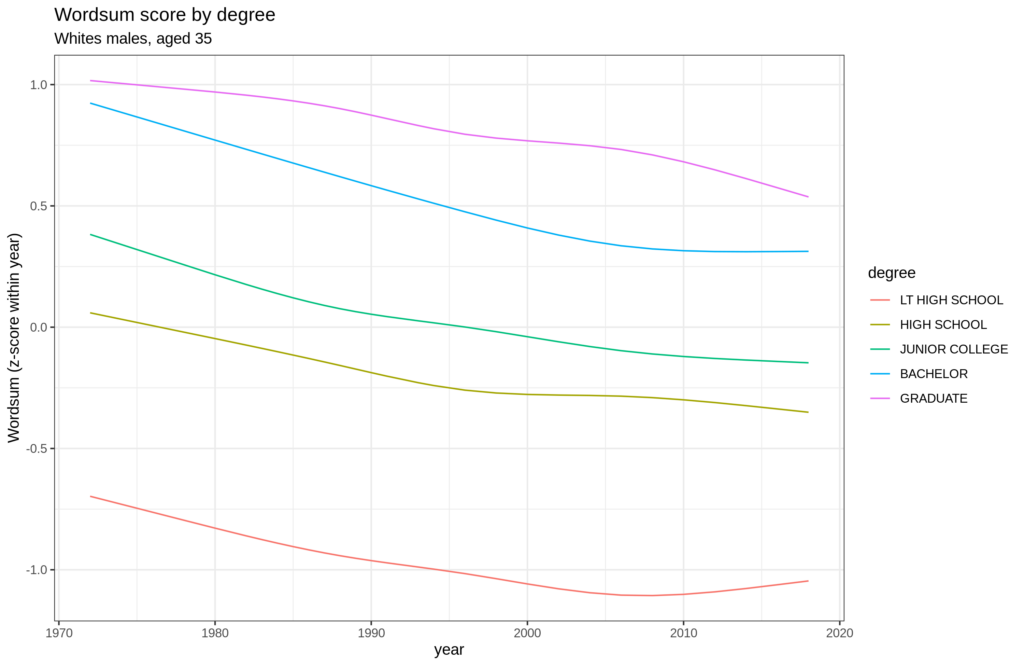
So people who had graduate degrees used to be about 15 IQ above the mean on this test, but now this has declined by above half to close to 8 IQs above the mean. I don’t have data for professors, but considering that professors, PhDs etc. are just further steps down this pipeline, we can expect this to also have happened there. A Danish study showed the decline for PhD students:
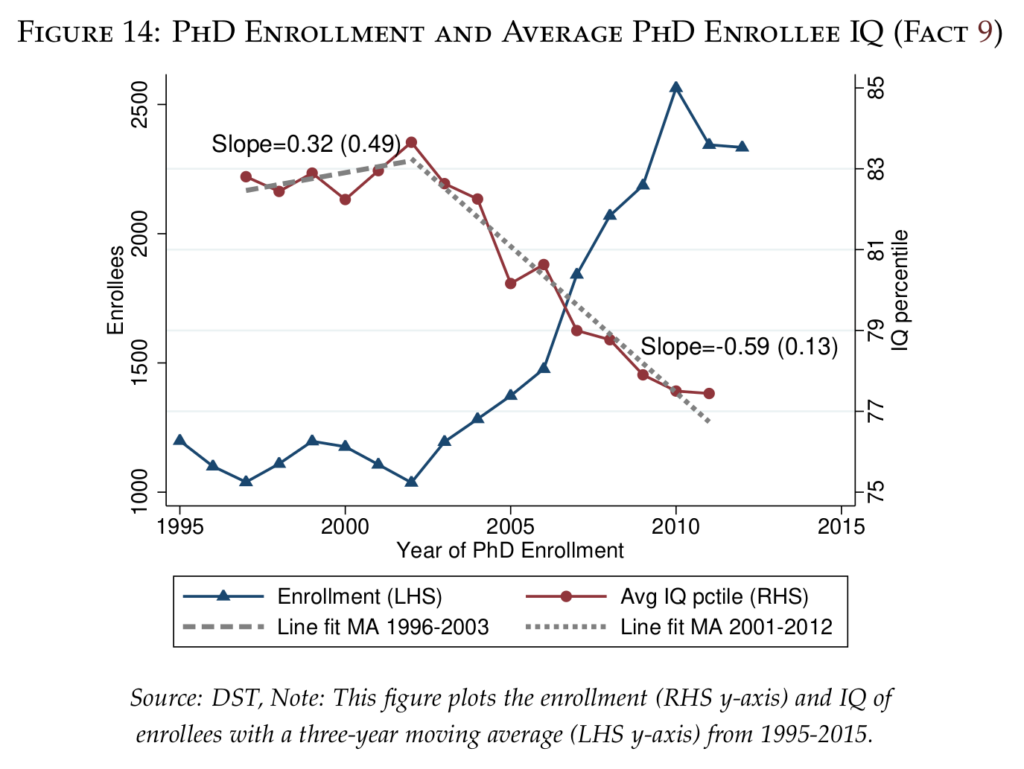
They seem to have incorrectly used centiles of intelligence as their metric. Centiles are nonlinear transformations, so taking a mean of centiles, and then converting to IQ will give a somewhat different number than taking the mean of IQs directly. I did some experimentation about this bias some time ago, and found it to be quite small, so we will ignore it here. The plot shows that Danish PhD students used to be about the 83th centile, i.e., 114 IQ in the years around 2000 (assuming Denmark = 100). That’s already very low considering that these are supposed to be researcher quality students. At this level of IQ, you can pick random people from Reddit with equal skill levels. Since the reform that lowered the standards, the centile mean has fallen to close to 77th, which is 111 IQ. Their data stops in 2011 so perhaps the decline has continued. It likely has, here’s the timeline for PhD students enrolled:

The database is nice enough to add breakdowns for areas. Looks like ‘medical science’ has about tripled since only 1996 (so soon we will live forever, right). Agricultural and humanities has apparently stayed about the same, which for the latter’s case is the most positive thing I’ve learned today. Still, we can see that the workforce being dedicated to science and tech is rather rapidly expanding, but as we already tried this method in the past to increase overall R&D speed, we can’t expect more of the same to work. In fact, the central concept diminishing returns does not appear anywhere in the book.
Governments could try to increase the size of the labour force by making it more attractive for people to have kids. But the data suggest this is very hard to do. Many European countries have extensive child benefits, but their fertility rates tend to be even lower than in the United States. The Hungarian government has been spending up to 5 percent of its GDP on fertility subsidies. For example, mothers with four or more children get a lifetime exemption from income tax.46 But they have only managed to raise the fertility rate from roughly 1.3 to 1.5.47 Though this is substantial, it’s far from reaching even the replacement rate. Even Hungarian levels of fertility subsidies wouldn’t suffice to avert stagnation.
Finally, we could avert stagnation if we develop breakthrough technology in time. We might develop artificial general intelligence (AGI) that could replace human workers—including researchers.48 This would allow us to increase the number of “people” working on R&D as easily as we currently scale up production of the latest iPhone. If we get to AGI before we stagnate, then longterm stagnation is not an issue; instead, as I argued in Chapter 4, we should then expect technological progress to advance much more rapidly, and we should worry instead about the possibility of value lock-in. Though I think there’s a significant chance we will develop AGI this century, we should not be confident that we will do so—AGI might just be very hard.49
Advances in biotechnology could provide another pathway to rebooting growth. If scientists with Einstein-level research abilities were cloned and trained from an early age, or if human beings were genetically engineered to have greater research abilities, this could compensate for having fewer people overall and thereby sustain technological progress. But in addition to questions of technological feasibility, there will likely be regulatory prohibitions and strong social norms against the use of this technology—especially against the most radical forms, which would be necessary to multiply effective research efforts manyfold. Human cloning is already within technological reach, but as a global society we’ve decided not to go forward with it—which may well be for the best, as human cloning could plausibly increase the risk of bad value lock-in.50
In sum, if we neither develop and deploy breakthrough technology in time nor see a renewed population boom, it doesn’t look like we’ll be able to keep quadrupling research effort. In that case, stagnation seems likely.
So now we get to the point where there is some indirect realization of the quality problem. Still, there is no discussion of embryo selection or direct genetic engineering to improve our “research abilities”. Why not? It’s not like futuristic books about this haven’t been written recently, even by philosophy colleagues, in 2020. The title is a near miss for the current book:

By the way, surveys of the use of biotech eugenics to improve intelligence of humans are not that discouraging. Here’s the 2018 Pew Research results:
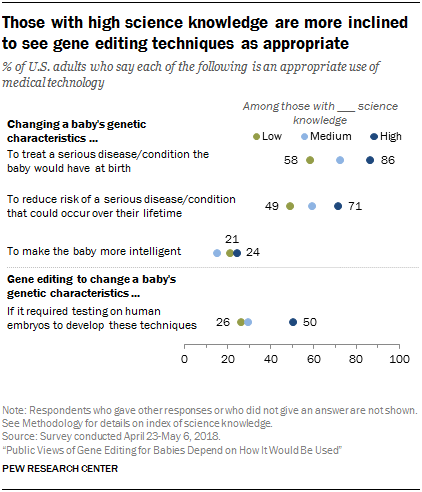
Let’s repeat that: people with more scientific knowledge are more likely to be in favor of genetically editing embryos to make babies more intelligent. In terms of countries, the most eugenicist country is India:

But note that China and Thailand were not included, and these are probably somewhat on the pro-side too.
So, as the public is woefully misled on these matters by variously lying or stupid journalists and academics, it would be helpful if this book didn’t indirectly contribute to this problem by pretending that cloning is the only known method, and that cloning is bad bad bad, rather than an OK technology to get started with.
A second reason why stagnation might last a long time is population decline. As we’ve seen, global population will plausibly not just plateau but shrink. Fertility rates almost everywhere are falling to substantially below 2. At 1.5 children per woman (roughly the average in Europe), within five hundred years the world population would fall from ten billion to below one hundred million; at one child per woman (roughly the fertility rate in South Korea), the world population would fall to one hundred million within two hundred years.57
In this situation, the bar for an outlier culture to restart technological progress is much higher. For example, they’d have to sustain high fertility rates for a long time to get world population back up to ten billion and beyond—a large enough population, with enough researchers, to start driving substantial new technological advances again. That’s hard, and a lot can happen in that time.58 Other one-off gains also become less potent. If a country can implement some policies to make researchers ten times more effective, that still might not suffice to restart growth if the world population has fallen to one hundred million. The deeper you’ve fallen, the harder it is to get out, and the expected length of stagnation would be greater.
The world population could also decrease dramatically as a result of a global catastrophe, like those discussed in the last two chapters. If a nuclear war or pandemic wiped out 99 percent of the world’s population, then, as discussed in the last chapter, we’d likely be able to recover industrial civilisation. But the dramatic population reduction would again make further technological progress very difficult—and the bar for an outlier culture to restart technological progress much higher.
Overall, we don’t know just how long stagnation would last. It’s possible that stagnation would be short, lasting only a century or two, but it’s also possible that it would be very long. Perhaps a stagnant future is characterised by recurrent global catastrophes that repeatedly inhibit escape from stagnation; perhaps cultural norms that are inconducive to progress become globally prevalent and are very persistent; perhaps we end up exhausting all recoverable fossil fuels in a stagnant future and the resulting extreme climate change further impedes growth. If some of these come to pass, then stagnation could potentially last for tens of thousands of years.
Taking this uncertainty fully into account means that the expected length of stagnation could be very great indeed. Even if you think it’s 90 percent likely that stagnation would last only a couple of centuries and just 10 percent likely that it would last ten thousand years, then the expected length of stagnation is still over a thousand years.
This discussion is based on his prior thinking about nuclear war wiping out a large fraction of humanity:
For concreteness, let’s consider what I would regard as an absolute worst-case nuclear scenario, in which 99 percent of the world population dies in the aftermath of an all-out war, leaving a global population of around eighty million. This is perhaps possible if weapons stockpiles greatly expand and weapons become much more powerful, or if other weapons, such as bioweapons, are also used. Using my definition of civilisational collapse as an event in which society loses the ability to create most industrial and postindustrial technology, we can now try to answer the first question: If 99 percent of the population died, would civilisation collapse?
Up until recently, this question had only very limited investigation, so I commissioned a report on the topic from Luisa Rodriguez, a researcher for Rethink Priorities who subsequently came to join my team. Luisa does not fit the typical stereotype of a “prepper”—someone who worries about and prepares for societal catastrophe. The daughter of a socialist who fled El Salvador and gained asylum in the United States, for most of her life she worked on pretty typical issues for a socially conscious member of the Left: as a teenager, she wanted to be a Peace Corps volunteer like her grandparents, and during university she oscillated between pursuing a career as an infectious disease doctor and one in international development nonprofits. Now she possesses a small stash of survivalist tools: heirloom seeds, because many of the plants grown on modern farms are hybrids that do not guarantee that desirable traits will be passed on the next generation; a flint-based lighter, because making fire is difficult; and a hand-crank emergency generator. On a date night with her partner, they created a plan for what to do if an apocalypse occurred, including where to meet if all communications infrastructure was down. I found this strangely romantic.
For all this, Luisa is fairly optimistic about the robustness of civilisation in the face of catastrophe. I share this qualified optimism: society probably would not collapse. But it is difficult to be completely sure, and when the stakes are so high, the risk of nonrecovery should be taken very seriously.
One set of reasons for optimism comes from the examples of postcatastrophe societies we have just discussed, such as Europe after the Black Death, Hiroshima, and Cuba. Even in the face of enormous local catastrophes, society recovered remarkably quickly.
There are also specific reasons to think that civilisation would not collapse if 99 percent of people died. Much of the physical infrastructure like buildings, tools, and machines would be preserved and could be used after the catastrophe. Similarly, most knowledge would be preserved, in the minds of those still alive, in digital storage, and in libraries: there are 2.6 million libraries in the world, with hundreds of thousands in countries without either nuclear weapons or alliances with countries with nuclear weapons.59 Critical skill sets would still remain: even if a catastrophe killed 99 percent of people, the chance that among the survivors there would be fewer than one hundred aeroplane engineers, nuclear power plant workers, organic chemists, or telecommunications engineers is close to zero. Two billion people today work in agriculture, with a sizable fraction working in smallholder subsistence farms, so it is exceptionally unlikely that we would lose all knowledge of agriculture.60
Finally, any large-scale catastrophe would be quite diverse in its impacts. Because all countries with nuclear weapons are in the Northern Hemisphere, the impacts of a nuclear winter would be more limited in the Southern Hemisphere; and because oceans retain heat, coastal areas would be much less affected.61 For coastal South America or Australia, a nuclear winter would result in a summer about five degrees cooler than usual,62 which would be bad but manageable. Similarly, if bioweapons were used, some island nations that were not involved in the conflict might be better able than other countries to defend against them by closing their borders. (Often, when worst-case disasters are modelled, New Zealand tends to come out relatively unscathed, which is why so many ultrarich preppers buy property there.63) So when we imagine a world in which 99 percent of people have died, we should not imagine this as being uniform across the world; rather, some countries would be devastated and some comparatively unaffected.
The book is so close to realizing the problem here. Suppose there is a nuclear war, which countries are going to get nuked? The good ones because generally speaking, bad countries do not have nuclear weapons and there is no reason to nuke them. So a nuclear war with say Russia vs. China vs. USA vs. Europe, would wipe out more or less the entire developed world. The calculations they did are assuming that talent and knowledge is equally distributed around the planet, but really, if there was a world nuclear war, a large fraction of the surviving humans would be poor Africans and Bangladeshi without any knowledge of anything academic. The loss of human knowledge would be much much more severe due to this selection factor. This makes nuclear war worries a lot more problematic, as waiting for these populations to rebuild civilization would take a long time. Possibly, evolution for higher intelligence in the colder climates would have to be redone, and this process took about 50,000 years last time (time humans have been in Europe, and a lot of this was wasted in ice ages).
The second premise is that, if we compare two populations with the same number of people, and the second population has both greater average and total wellbeing, and that wellbeing is perfectly equally distributed, then that second population is better than the first. This premise is known (catchily!) as Non-Anti-Egalitarianism (Figure 8.6). The basic idea behind this premise is that equality is not actively bad. While some people deny that equality is intrinsically good, to my knowledge no one thinks that equality makes the world worse, all other things being equal.
He might want to look at some maps of global well-being before getting called nasty names:
The trend for wild animals is less clear. Human expansion means that the biomass of wild land mammals has decreased by a factor of seven compared to prehuman times, mostly due to the megafaunal extinctions I discussed in Chapter 2.80 The biomass of commercially caught predatory fish has declined dramatically, but this has been to some extent offset by an increase in the biomass of smaller prey fish.81 On balance, various studies suggest that human activity over the last forty years has probably decreased vertebrate and invertebrate populations, though the evidence is limited and somewhat conflicting.82 How you evaluate this depends on your view on wild animal wellbeing. It’s very natural and intuitive to think of humans’ impact on wild animal life as a great moral loss. But if we assess the lives of wild animals as being worse than nothing on average, which I think is plausible (though uncertain), then we arrive at the dizzying conclusion that from the perspective of the wild animals themselves, the enormous growth and expansion of Homo sapiens has been a good thing.
This reminds me of my favorite troll argument against vegans. What if we breed cows to be exceedingly happy and love sacrificing themselves to humans? Basically, we breed cows to have the personality disposition of dogs with added good taste and fast growth. It would then be unethical to not keep breeding them. And the only way to make that economically work out, is to keep eating them.
Personal fit is, in addition, one of the main ingredients of job satisfaction. People often associate altruism with self-sacrifice, but I think that for the most part, that is the wrong way to think about it. For me personally, since I started trying to do the most good with my life, I feel that my life is more meaningful, authentic, and autonomous. I am part of a growing community of people trying to make the world a better place, and many of these people are now among my closest friends. Effective altruism has added to my life, not subtracted from it. There is, moreover, a pragmatic reason to do a job you enjoy: it makes your impact sustainable over the long term. You want to be able to sustain your commitment to doing good for over forty years rather than think about how you can do as much good as possible this year. The risk of burnout is real, and you will work better with other people and be more productive if you are not stressed or depressed.
Cult-o-meter going bing bing bing. With regards to sacrifices, it reminds me of the prior sections on fertility. He notes that government tax policies etc. have largely failed to increase fertility, but he does not discuss things that might work, like banning abortion as some dictators have tried in the past, or in general, having authoritarian policies that are explicitly and thoroughly pro-fertility. If low population size extinction risk and technological stagnation is such a big concern, then surely it is worth looking into this means.
Overall, this is a nice book. It has some blind sides on matters of human biodiversity, eugenics, and all the good stuff, but the discussions of stagnation risks are very much welcome, especially as they are not overly focused on obviously stupid global warming alarmism (a 4 degree world temperature increase is not going to cause civilization to decline). There is also a lot of nice stuff defending open mindedness and diversity of thought. Take this passage:
A second reason ties back to our earlier discussion of cultural evolution. When technological innovation is possible, there are great economic gains to be had from critical thinking and scientific inquiry; and since economically successful cultures gain more members, cultural evolution currently selects for traits conducive to science. As a side effect, so this argument goes, we apply our critical capacities to moral issues, too, and therefore make moral progress. In a stagnant world, the economic reasons to engage in critical thinking and scientific inquiry would be much weaker. Instead, other values would be selected for, such as those favouring hierarchy and conformity, which have guided so many societies in the past.
Even more important than the values during stagnation are whatever values will eventually get the world out of it—for these are the ones that will become predominant in the longer term. These aren’t necessarily values that prize critical thinking and inquiry. For example, the prevailing moral worldview could simply be whatever one most champions very high fertility; perhaps this would be a worldview with very inegalitarian gender norms. Or it could be whatever worldview is most willing to break social taboos in the pursuit of economic gains. Perhaps the worldview of whichever country is first willing to use human cloning and genetic engineering will dominate. There’s no reason at all to expect this to be an egalitarian and democratic society rather than a fascist or authoritarian regime.
This is all speculative, and I’m not sure which of these perspectives on future moral progress is more correct. I see the questions of whether we should expect values to get better or worse into the future and under what conditions, as crucial and open. At the moment, the issue is extremely underexplored, so I won’t draw any strong conclusions.61
